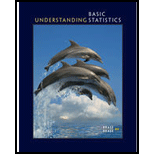
Concept explainers
Please provide the following information for Problems 11-22. part (a):
(i) What is the level of significance? State the null and alternate hypotheses.
(ii)Check Requirements What sampling distribution will you use? What assumptions are you making? What is the value of the sample test statistic? Compute the corresponding z or t value as appropriate.
(iii)Find (or estimate) the P-value. Sketch the sampling distribution and show the area corresponding to the P-value.
(iv)Based on your answers in parts (i)—(iii), will you reject or fail to reject the null hypothesis? Are the data statistically significant at level a?
(v)Interpret your conclusion in the context of the application.
Note: For degrees of freedom d.f. not in the Student's t table, use the closest d.f. that is smaller. In some situations, this choice of d.f. may increase the P-value a small amount, and therefore produce a slightly more “conservative” answer. Answers may vary due to rounding.
Education: Tutoring In the journal American Journal on Intellectual and Developmental Disabilities, an article reported the results of a peer tutoring program to help mildly mentally retarded children learn to read. In the experiment, the mildly retarded children were randomly divided into two groups: The experimental group received peer tutoring along with regular instruction, and the control group received regular instruction with no peer tutoring. There were
(a) Use a 5% level of significance to test the hypothesis that there was no difference in the vocabulary scores of the two groups before the instruction began.
(b) Find a 95% confidence interval for
Want to see the full answer?
Check out a sample textbook solution
Chapter 10 Solutions
UNDERSTANDING BASIC STATISTICS (LOOSE)
- The following data represent total ventilation measured in liters of air per minute per square meter of body area for two independent (and randomly chosen) samples. Analyze these data using the appropriate non-parametric hypothesis testarrow_forwardeach column represents before & after measurements on the same individual. Analyze with the appropriate non-parametric hypothesis test for a paired design.arrow_forwardShould you be confident in applying your regression equation to estimate the heart rate of a python at 35°C? Why or why not?arrow_forward
- Given your fitted regression line, what would be the residual for snake #5 (10 C)?arrow_forwardCalculate the 95% confidence interval around your estimate of r using Fisher’s z-transformation. In your final answer, make sure to back-transform to the original units.arrow_forwardCalculate Pearson’s correlation coefficient (r) between temperature and heart rate.arrow_forward
 Glencoe Algebra 1, Student Edition, 9780079039897...AlgebraISBN:9780079039897Author:CarterPublisher:McGraw Hill
Glencoe Algebra 1, Student Edition, 9780079039897...AlgebraISBN:9780079039897Author:CarterPublisher:McGraw Hill College Algebra (MindTap Course List)AlgebraISBN:9781305652231Author:R. David Gustafson, Jeff HughesPublisher:Cengage Learning
College Algebra (MindTap Course List)AlgebraISBN:9781305652231Author:R. David Gustafson, Jeff HughesPublisher:Cengage Learning

